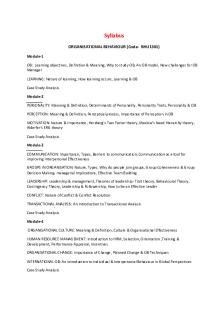CVEN2303 - Full Notes PDF

| Title | CVEN2303 - Full Notes |
|---|---|
| Author | Anonymous User |
| Course | Structural Analysis and Modelling |
| Institution | University of New South Wales |
| Pages | 29 |
| File Size | 3 MB |
| File Type | |
| Total Downloads | 9 |
| Total Views | 156 |
Summary
CVEN2303 lecture summaries...
Description
CVEN2303 – STRUCTURAL ANALYSIS AND MODELLING WEEK 1 - INTRODUCTION LECTURE 1 NOTES STRUCTURAL ANALYSIS
Statically Indeterminate Structures: three equations of equilibrium are not enough. o Flexibility Methods: Equilibrium Material Properties (Stress-Strain) o Stiffness Methods: Geometry (Compatibility) Plane Trusses and Frames only. Some assumptions are: o Loads are Static Loads are applied slowly to avoid unnecessary variants. o Small Displacements Deflection is much smaller than the height and length of the beam (100x). o Linear Elastic Behaviour Linear material has a linear stress-strain relationship. Elastic material is where pressure is applied to an object but when released it returns to its original position. Aim is: o To calculate Internal Forces (M, N, S). o To calculate Deformations.
TYPES OF STRUCTURES Trusses:
Frames:
Cables and Arches:
Arches:
2
Domes:
STRUCTURAL ELEMENTS
Rods Beams Columns Stocky/Slender/Buckling
STRUCTURAL IDEALISATION
3
DETERMINACY, INTEDETERMINACY, STABILITY Equations of Equilibrium:
Plane Trusses:
Determinacy and Stability:
A truss is considered to be stable when these two conditions exist: o At least three reaction forces that restrain the horizontal and vertical movement of the truss, and the lines of action of the reactions do not intersect. o The truss is composed from triangular or cross shapes.
REVIEW OF INTERNAL FORCE DIAGRAMS
4
Axial Forces (AFD) Shear Forces (SFD) Bending Moments (BMD)
NOTATION
MATHMATICAL RELATIONS
ZERO SHEAR FORCE = MAXIMUM BENDING MOMENT
5
BASIC DIAGRAMS
EXAMPLE 1 – BEAM WITH TRIANGULAR LOAD
6
7
EXAMPLE 2: BEAM WITH CONCENTRATED MOMENT
8
EXAMPLE 3 – TYPICAL FRAME
9
EXAMPLE 4 – FRAME WITH TRIANGULAR LOADING
10
11
EXAMPLE 5- FRAMES WITH INCLINED MEMBERS
WEEK 2 – CONJUGATE
12
BEAM METHOD
LECTURE NOTES - DEFLECTIONS OF BEAMS USING CONJUGATE BEAM METHOD DEFLECTIONS AND ROTATIONS FOR BASIC CASES
CONJUGATE BEAM-METHOD
13
14
The conjugate beam is loaded with the M/EI diagram derived from the load q on the real beam. Its equilibrium solution gives the slopes and deflections of the real beam. We can state 2 theorems related to the conjugate beam: o The slope at a point in the real beam is numerically equal to the shear at the corresponding point in the conjugate beam. o The displacement of a point in the real beam is numerically equal to the moment at the corresponding point in the conjugate beam. When drawing the conjugate beam, it is important that the shear & moment developed at the supports of the conjugate beam account for the corresponding slope & displacement of the real beam at its supports.
If the real beam is statically determinate then the conjugate beam is also statically determinate. The opposite is not true! For consistency of the solution: if the bending moment is causing tension at the lower side of the real beam, then it will be applied as an equivalent force of M/EI acting downwards on the conjugate beam, and vice versa. As a result: a moment that is causing tension at the lower side of the conjugate beam means a downloads deflection of the real beam, and vice versa.
EXAMPLE 1 – CANTILEVER BEAM
EXAMPLE 2 – SIMPLY SUPPORTED BEAM WITH A POINT LOAD
15
EXAMPLE 3 - SIMPLY SUPPORTED BEAM WITH UDL
EXAMPLE 4 – BEAM WITH VARIABLE EI
16
EXAMPLE 5 – BEAM WITH INTERMEDIATE HINGES
17
EXAMPLE 6 – APPLICATION TO STATICALLY INDETERMINATE BEAMS
18
WEEK 3 – THE PRINCIPLE OF WORK
19
20
21
22
23
24
25
26
27
28
29...
Similar Free PDFs

CVEN2303 - Full Notes
- 29 Pages

FULL Notes
- 229 Pages

Full notes
- 102 Pages

Indian ethos notes full notes
- 10 Pages

HSC SOR Full Notes
- 39 Pages

Psycho Bio - Full notes
- 30 Pages

full modules notes
- 44 Pages

MKT390 full exam Notes
- 76 Pages

CHM1011 Full Notes
- 61 Pages

FULL EU EXAM Notes
- 51 Pages

MKTG2113 Full Notes
- 55 Pages

Business Management Full Notes
- 47 Pages

Business Statistics FULL NOTES
- 56 Pages

Mendalin Genetics - full notes
- 13 Pages

Medical Terminology Full Notes
- 37 Pages
Popular Institutions
- Tinajero National High School - Annex
- Politeknik Caltex Riau
- Yokohama City University
- SGT University
- University of Al-Qadisiyah
- Divine Word College of Vigan
- Techniek College Rotterdam
- Universidade de Santiago
- Universiti Teknologi MARA Cawangan Johor Kampus Pasir Gudang
- Poltekkes Kemenkes Yogyakarta
- Baguio City National High School
- Colegio san marcos
- preparatoria uno
- Centro de Bachillerato Tecnológico Industrial y de Servicios No. 107
- Dalian Maritime University
- Quang Trung Secondary School
- Colegio Tecnológico en Informática
- Corporación Regional de Educación Superior
- Grupo CEDVA
- Dar Al Uloom University
- Centro de Estudios Preuniversitarios de la Universidad Nacional de Ingeniería
- 上智大学
- Aakash International School, Nuna Majara
- San Felipe Neri Catholic School
- Kang Chiao International School - New Taipei City
- Misamis Occidental National High School
- Institución Educativa Escuela Normal Juan Ladrilleros
- Kolehiyo ng Pantukan
- Batanes State College
- Instituto Continental
- Sekolah Menengah Kejuruan Kesehatan Kaltara (Tarakan)
- Colegio de La Inmaculada Concepcion - Cebu
